In the previous installment of this series, it was shown that (sub-micron) abrasive stropping produces convexity in the last few microns of the edge; this result was defined as micro-convexity. In this article, the role of the strop material is examined and insensitivity to the number of laps (stropping strokes) is investigated. The challenge of avoiding a foil edge burr with diamond stropping is also discussed.
In the first example, we start with a razor honed with a DMT EF (1200) plate; the nearest to a “toothy edge” that we have observed so far. The blade was stropped 3 times (return strokes) on a 10 inch long balsa wood strop loaded with 0.25 micron mono-diamond. The effect is dramatic and clearly shows how rapidly pasted stropping is accomplished.


It is interesting to note that the distance traveled by the blade in those three laps (approximately 75cm) is 3 million times the diameter of the abrasive particle (0.25micron). This is approximately the number of steps required to walk from New York City to Miami. Whether we define three laps as “not many” is a question of scale.
This three-lap result may suggest that if pasted stropping works so rapidly, too many strokes must be avoided; however, this is not necessarily the case. Below is shown a set of cross-section images following 10, 100 and 500 return laps on a chromium oxide loaded horsehide hanging strop. The effect is again rapid, with the edge already micro-convex after only 10 laps. The degree of micro-convexity appears to reach an equilibrium in the range of 30 laps (not shown). Very little change is observed between 100 laps and 500 laps. A slight foil burr is formed at high stroke counts, and this would require additional stropping on an appropriate strop to clean-up and maximize keenness. A blade stropped on chromium oxide generally benefits from further stropping on finer abrasive or a just a clean leather strop to enhance keenness. Nonetheless, there is no runaway convexity occurring with large numbers of strokes in this case. This result will not be surprising to anyone who maintains their straight razor with daily application of a pasted strop.
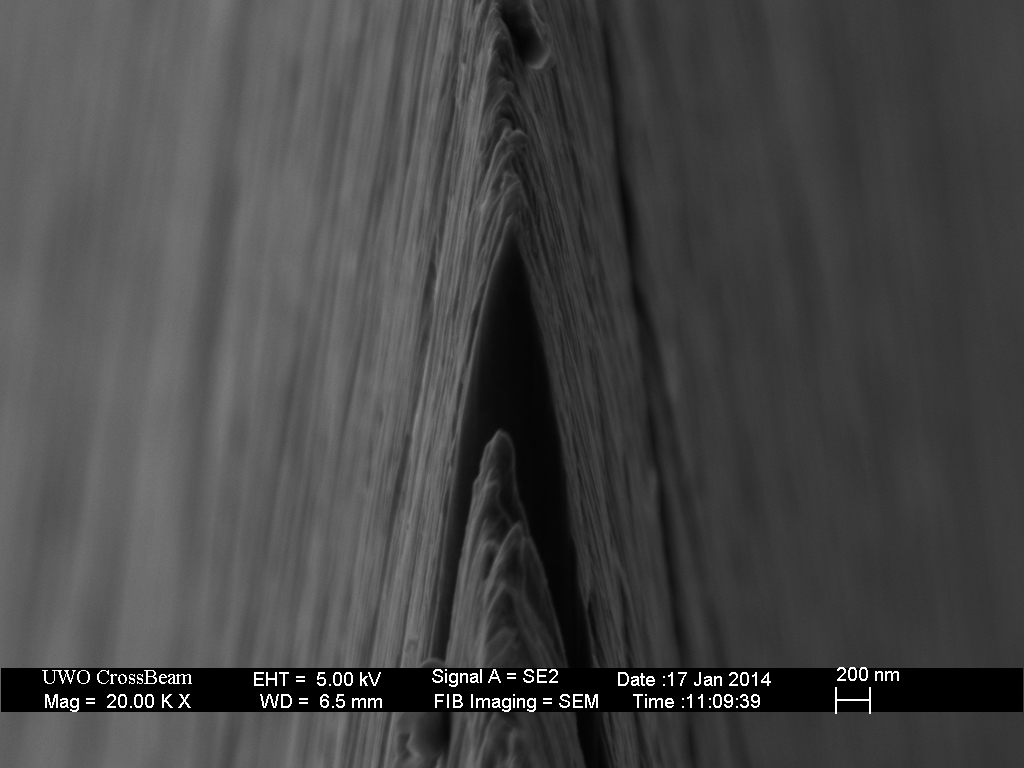


The next example shows the effect of 250nm mono-diamond on balsa wood following honing to the 8K level in a Shapton glass stone progression. The Shapton 8k blade (edge leading) is shown in the Honing Progression entry and has a typical edge width of 150nm. This particular razor has a 16.5 degree (included) spine-edge angle prior to stropping. The image shows that the micro-convexity introduced by the balsa strop affects only the last 0.3 microns of the apex. Nonetheless, the edge width is reduced to the 50nm level as a result of that micro(nano)-convexity. Minimal convexity results in this case because the balsa wood strop is rigid and nearly incompressible.

Essentially opposite to balsa wood, Nanocloth is very soft and flexible (although mounted on a hard, flat glass substrate). The images below show that the amount of micro-convexity introduced is only slightly greater than from the balsa substrate. This observation indicates that micro-convexity is not simply a result of strop compressibility.
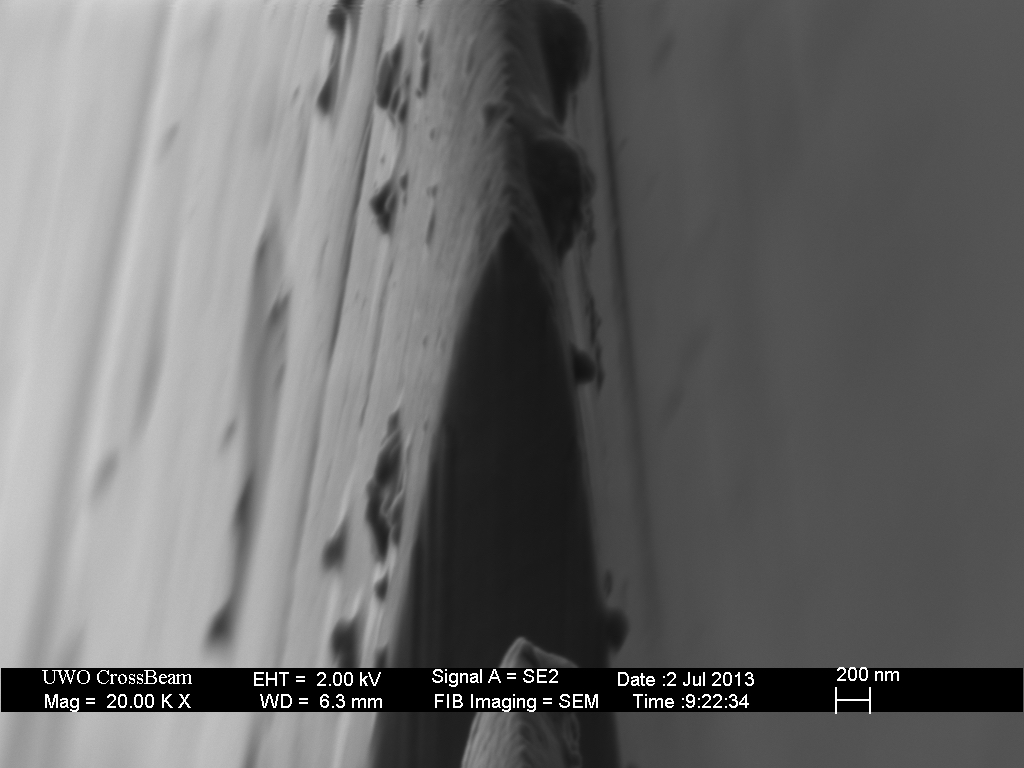

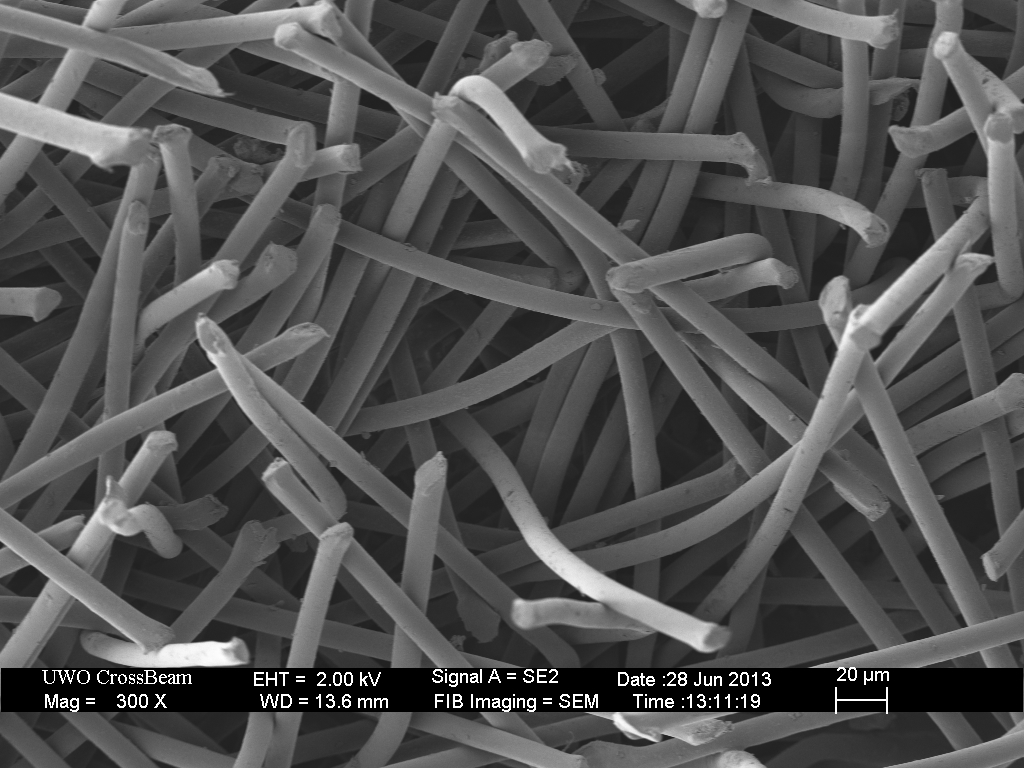
In the next example, we use a strop that is both flexible and resilient, latigo (bovine) leather. The Shapton 8k honed blade was stropped on the hanging latigo loaded with 0.25 micron mono-diamond. This pasted strop produces significant micro-convexity and as side-effect also produces a foil-edge burr. Although it may appear to be insubstantial, this foil is sufficiently robust and flexible to negatively impact the shaving efficiency of the blade. Shaving with a razor with such a foil edge burr generally results in extreme levels of skin irritation.
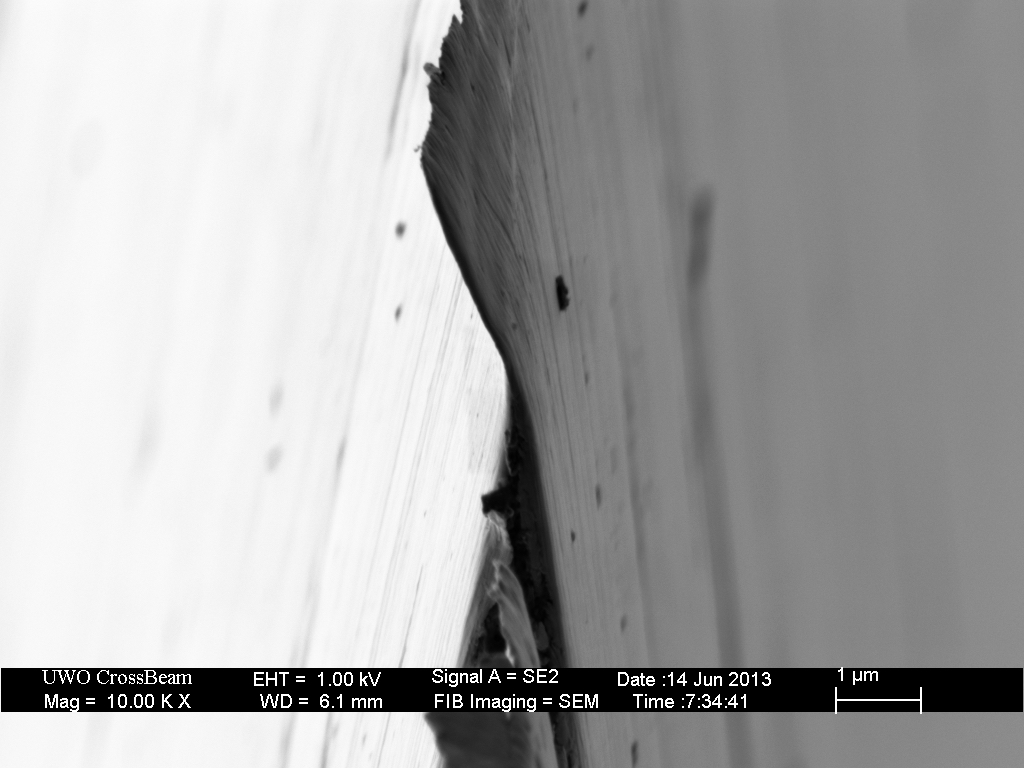

The razor was then given another 90 laps on the 0.25 micron diamond on latigo for a total of 100 laps. The foil is diminished in thickness and length, but it still present along much of the edge. Shaving with such a razor would cause skin irritation, while breaking away the burr, and leaving less than optimal keenness. Further stropping could bring the blade to comfortable shaving geometry.
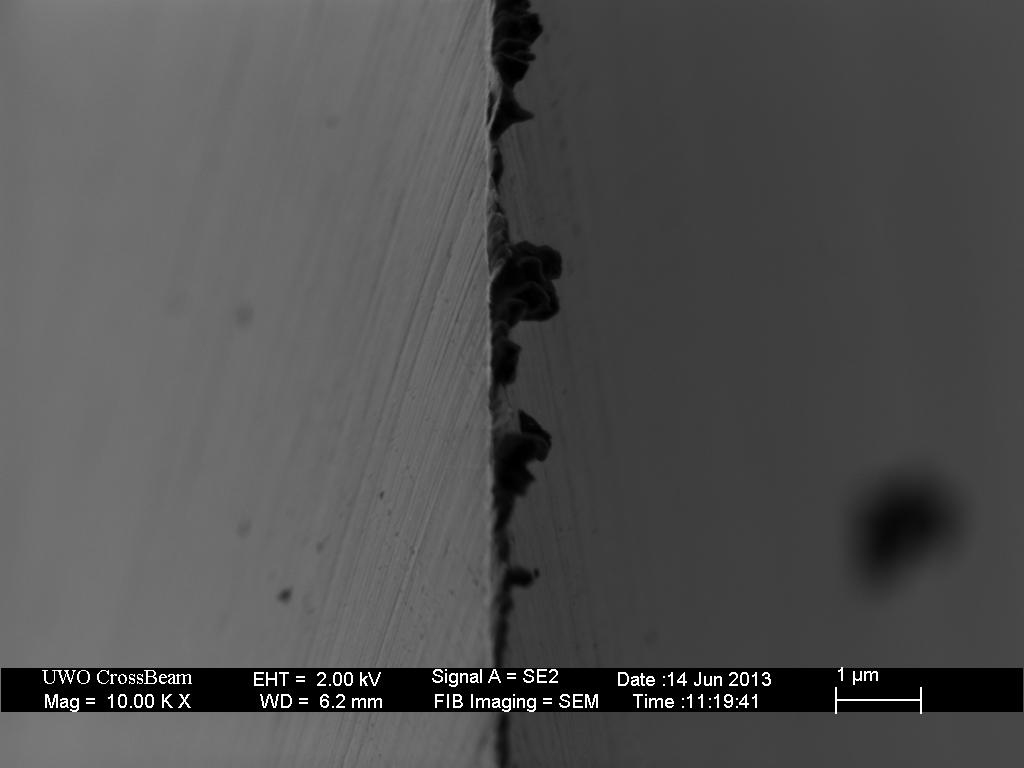
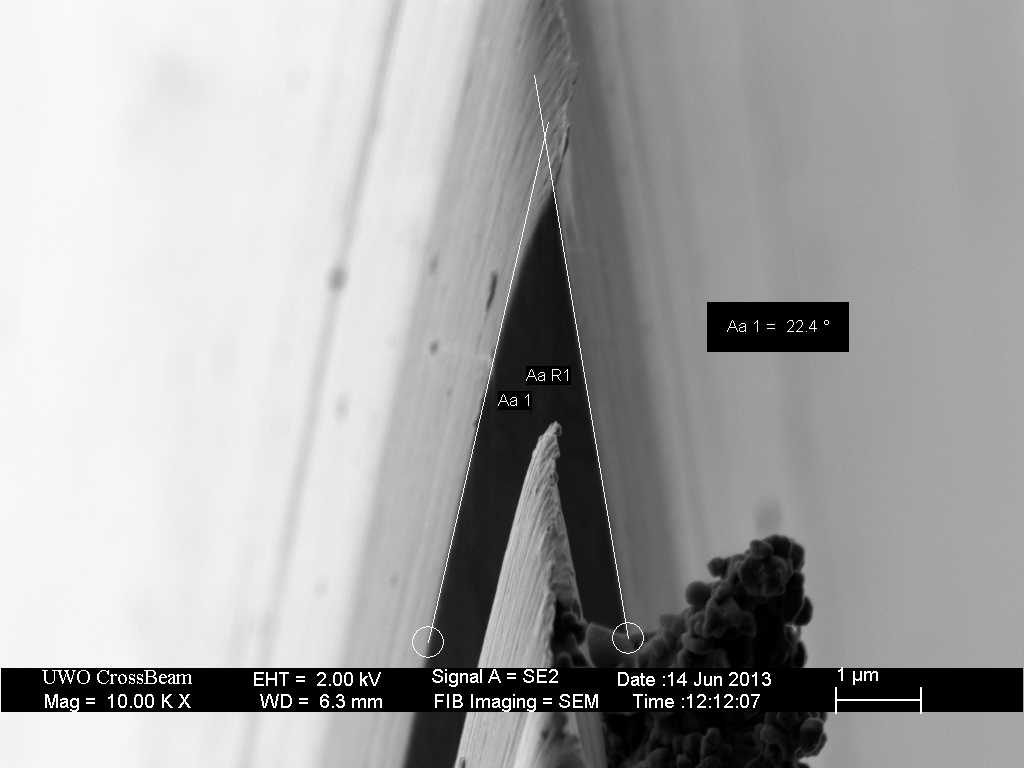

For comparison, a razor was again honed to the Shapton 8k level but this time stropped 10 laps on 0.5 micron mono-diamond on a latigo strop. The result is similar to that observed for the 0.25 micron case; however, steel removal occurs more rapidly. The increased rate of abrasion with particle size is expected; however, there is no significant difference in the edge geometry. This effect requires further study, but it appear that the abrasive size has little impact on the resulting geometry. Clearly the material of the strop plays a far greater role.
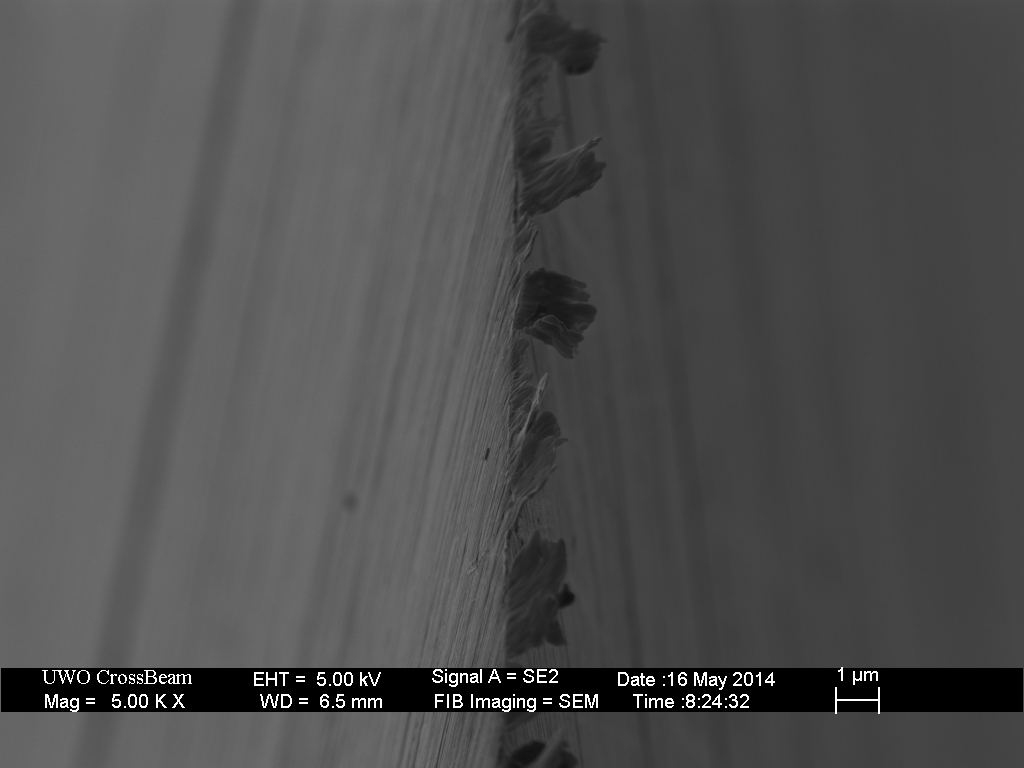
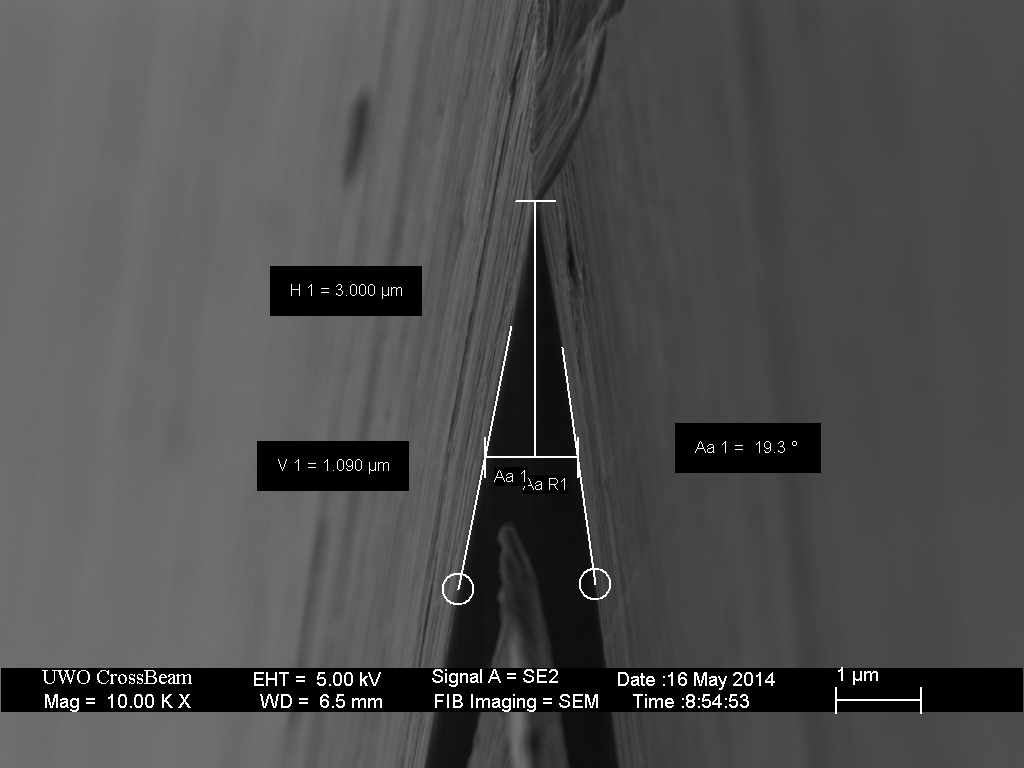
In the final example, a blade was honed to the Shapton 8k level and then stropped on a hanging denim strop loaded with Thiers Issard Pate a Rasoir, a coarse (10 micron) aluminum oxide abrasive. Not only is there significant micro-convexity, but the entire bevel has started to convex as evidenced by the increase in angle away from the apex. The significant metal removal rate provides another example of the role of abrasive particle size in the stropping process. The edge width is approximately 100nm with small burrs along some parts of the edge. Additional stropping on linen and clean leather will typically remove these burrs and improve keenness.


The blade shown above was then stropped 10 laps on the same 0.25 micron mono-diamond on the latigo leather strop that produced the foil edges shown earlier. The burr formed in this case is extremely subtle compared to the burr produced on the blade that was not first micro-convexed. This observation provides further evidence that the foil edge burrs produced by the latigo strop are a result of the geometry transition from triangular to micro-convex. Very fine, flexible burrs can be difficult to remove without sacrificing keenness, so avoiding burr formation is always preferable. One effective approach is to first micro-convex the apex with a more aggressive strop, with fabric and coarser abrasives for example.
The physics underlying the formation of micro-convexity can be visualized with the image below. In this model, the lower piece of foam represents the strop and the upper piece of foam represents the blade. To the left of the apex, the strop uniformly compressed by the blade. To the right of the apex, the strop is uniformly uncompressed (relaxed). The transition between these two regions creates a greater pressure on the blade near the apex. The increased pressure results in faster abrasion rates until the apex geometry reaches the equilibrium profile. This equilibrium shape can be visualized in this example by the line of the paper between the two foam slabs. Once the blade has been convexed to that equilibrium geometry, the pressure will be equal along the bevel all the way to the apex and abrasion will occur uniformly, maintaining that equilibrium (micro-convex) profile. For this reason, micro-convexity is introduced rapidly and that geometry remains essentially unchanged with further stropping.

In summary, examples have been provided to evidence the following observations:
Abrasive stropping rapidly micro-convexes the apex. Additional stropping, up to many hundreds of strokes does not substantially increase the micro-convexity.
Bevel convexity, as distinct from micro-convexity, is not apparent in sub-micron abrasive stropping, but does occur with larger abrasive particles. The quantity of metal that must be removed to convex the entire bevel will result in blackening of the strop, something generally not observed with sub-micron abrasive strops.
The apex geometry is determined primarily by the strop material rather than the abrasive size.
The transition from triangular to micro-convex bevel geometry can result in the formation of a foil edge burr for resilient (springy) strop materials. This is almost certainly the reason some people are unsuccessful with 0.25 micron diamond spray. If the apex is convexed on a more aggressive strop first, the edge can be finished on that resilient strop without foil edge burr formation.
These observations suggest that a successfully designed stropping progression should involve different strop materials rather than different sized abrasives on the same substrate. This is partly why the traditional combination of linen and leather are so effective at maintaining a straight razor.

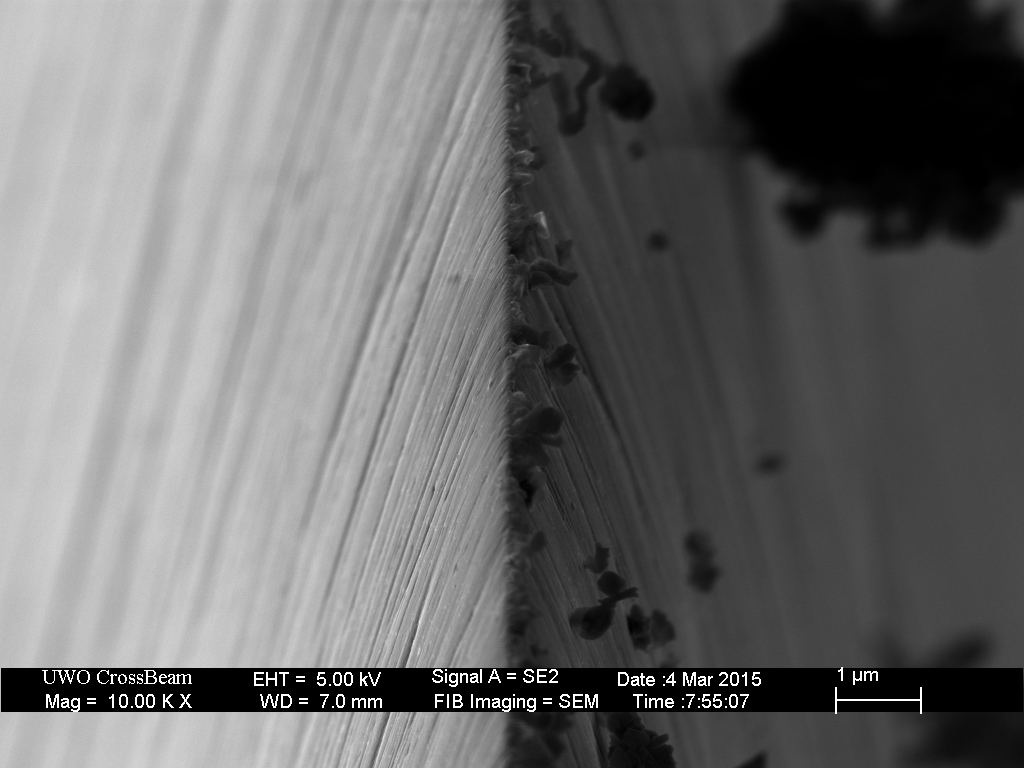

58 responses to “The Pasted Strop – part 3”
Thanks for all your work.
I’m curious, why is it that a progression of 0.5 micron to 0.25 on different strop material will not cause a foil edge?
Shouldn’t the mechanism that caused a foil edge on the .25micron also cause one on 0.5 microns?
LikeLike
On the same strop material, the 0.5 have the same effect as the 0.25, only about 5 times faster.
LikeLike
“The transition from triangular to micro-convex bevel geometry can result in the formation of a foil edge burr for resilient (springy) strop materials. This is almost certainly the reason some people are unsuccessful with 0.25 micron diamond spray. If the apex is convexed on a more aggressive strop first, the edge can be finished on that resilient strop without foil edge burr formation.”
So, if i microconvex an edge, on a strop with more ‘give’ like a hanging strop during pre-finishing, then i want to finish on a firm strop like balsa using submicron abrasives, if i add one layer of tape during the finishing on the balsa, will the edge apex make contact with the substrate? I believe it will , because the more firm balsa doesn’t give much at all with the ultra light pressure. Another factor too on the Balsa, the spine doesn’t compress onto the balsa the way it does when stropping on a hanging loaded strop, meaning both edge and spine compress into a hanging strop. Or i should say that both edge and spine would conform to the hanging strop, verses the firm strop, so the firm strop would increase the angle a bit more because the spine doesn’t compress.
LikeLike
Todd, I really enjoyed your scientific approach to stropping.
I have to admit I feel a bit lost in the details.
Would you be so kind and summarise in a few words, what stropping routine would you recommend to maintain a good cutting edge for kitchen knives ?
Thank you for your work
LikeLike
Mihai,
I will need a few more entries on this topic before I can give an executive summary. For my kitchen knives and pocket knives – when the edge is lacking keenness but does not feel chipped or rough, I will use a 0.5 micron diamond abrasive on leather. If it needs more steel removal, I might try 10 micron plus (metal polish, etc) abrasive on denim. Alternatively, a quick micro-bevel with a stone/hone/steel/rod followed by the 0.5 micron strop. There are many ways to achieve the same result, this is just what I am experimenting with at the moment.
LikeLiked by 2 people
So, you say there will be a Part 4 for this series ? I can’t wait to read it.
What would be the best substrate for 3M 0.5 micron film abrasives? Did I understand correctly that the substrate should be softer to avoid formation of foil edge ?
I chose 3M abrasive instead of some generic compound based on this site: http://www3.telus.net/BrentBeach/Sharpen/Stropping.html#April2012
Brent says that compounds like Lee Valley have a great pecentage of particles in grit much larger than the advertised grit .
Regards !
LikeLike
Lapping film falls somewhere between a stone and a strop in resilience (compressibility). With edge-trailing strokes it will form a foil edge readily. Unfortunately, edge-leading strokes do not entirely avoid foil edges with lapping film. Placing one or two sheets of wet paper between the film and a hard substrate produces micro-convexity, and generally prevents foil edge formation (with edge leading strokes).
LikeLiked by 2 people
Thank you again
LikeLike
Thanks for all work and presentation!
How would you rank these edges of your respect to shave performance?
1. 16k 10 laps chromium oxide
2. 16k 100 laps chromium oxide
3. 16k 500 laps chromium oxide
4. 8k 100 laps 0.25 mono-diamond on balsa
5. 8k 100 laps 0.25 cubic boron nitride on nano cloth
6. 8k 10 laps 0.25 mono-diamond on hanging latigo strop.
7. 8k 100 laps 0.25 micron mono-diamond hanging latigo
8. 8k 10 laps on 0.5 micron mono-diamond latigo strop.
9. 8k stropped on a hanging denim strop loaded with Thiers Issard Pate a Rasoir, a coarse (10 micron) aluminum oxide abrasive. stropped 10 laps on the same 0.25 micron mono-diamond on the latigo leather.
Also I wonder about side stropping to remove burr.
LikeLike
Chromium oxide does not leave a particularly burr-free, keen edge and requires stropping on clean linen/leather after. It provides a simple method for micro-convexing the apex, particularly useful for finishing a synthetic progression.
Diamond on balsa produces a very keen edge, but without microconvexity it tends to fail rapidly on a tougher beard, producing the familiar “harsh” shave.
Nanocloth does an excellent job of avoiding or removing burrs, but does not produce an edge keen enough for my preference.
Following an 8k edge, 0.25 diamond stropping produces a foil edge and a very “harsh” shave. With sufficient stropping, the foil can be minimized (100 laps). 0.5 micron has the same effect as 0.25, only 3-5 times faster, so 10 laps on 0.5 is equivalent to 30-50 on 0.25.
The 8k/TI Pate a Rasoir/0.25 diamond on latigo very reliably produces an excellent shaving edge. The coarse TI paste micro-convexes the apex to an extent that prevents the 0.25 diamond from producing a foil. I have been test shaving with razors honed by this progression daily for nearly 6 months. I would recommend this progression to anyone who is learning to use abrasive stropping to maintain a straight razor.
LikeLiked by 1 person
Awesome work and thanks for doing this!
I’d like to apply this to knife sharpening.
When you say “8K/TI Pate a Rasoir/0.35 diamond on latigo”, you mean the TI Pate a Rasoir on latigo and then the diamond on latigo as well? So a two step stropping after the stone?
Thanks
LikeLike
I use the TI paste on a strip of denim taped to the edge of my bench. Any aluminum oxide metal polish does the same. This probably works best with 15dps bevel angle (or less) I strop with the knife flat like a razor making contact with the apex by pressure and or strop flex. The diamond is on Latigo.
LikeLiked by 1 person
Thank you for your meticulous work!
A couple years ago, I tried .25 diamond spray on a felt backed bench strop after a stone progression through 12k and 16k on several occasions and with several razors and found the shave very harsh as you indicated here.
Yesterday, I took two well-shaving razors and stropped them 30 times on nylon webbing loaded with metal polish then 30 times on a bovine leather strop loaded with .25 diamond. I finished by stropping 5 laps on a tight weave linen strop then 50-100 on a leather strop. Amazingly keen edge and a smooth shave, thank you!
It seems that after an 8k edge, TI pate a razoir, .25 diamond on latigo progression, you still formed a subtle burr. How do you explain the smooth shave off this progression? Is the thin burr removed through leather stropping?
In your experience, how have you been maintaining this edge?
Have you experimented with maintaining this edge with .125 or .1 CBN on any material?
Once you follow this pasted progression and micro-convexing procedure, what impact does further stropping on sub-micron abrasive have?
LikeLike
I have honed and shaved with approximately 150 razors using this approach, varying the preceding stones, pressure, direction, number of laps, etc. and have found it to be an incredibly forgiving of technique. It is possible to leave a subtle burr after the diamond on leather if more pressure is applied on the diamond/leather than on the denim with metal polish. These subtle burrs should easily be removed during stopping on clean linen.
It is important to understand that stropping does NOT continue to convex the blade after the first handful of laps, so to refresh the blade you need to remove some metal with a fine hone. I would suggest doing 20-30 back-and-forth strokes on an 8k, then 5-10 edge leading and then 5-10 edge trailing strokes prior to the 30 laps on the denim/metal polish and 30 laps on the leather/diamond. Obviously if you have damaged the blade, you will need to go coarser first to remove any chips. The blade should easily tree-top the finest arm hair after this refresh – if it does not then you likely need to reset the bevel at 1k or 2k level.
I not observed an improvement in keenness or shaving comfort by stropping with abrasive finer than 0.25 micron. I do have a couple of new 0.05 micron abrasives to try when I have time.
LikeLike
Thanks for posting the results of your experiments on sharpening for those of us without access to electron microscopes. I have a question about the abrasives you use – will they also work with hard steels like m42? I am planning on making a roughing gouge with m42 as it retains an edge longer and does not lose temper when heated.
Thanks,
Arvind
LikeLike
Is there a way to sharpen a micro convex edge without remove most of the convexity with a natural whetstone?
Are there 10 micron aluminium oxide paste sold in stores?
I can not find Thiers Issard Pate a Rasoir 10 micron aluminum oxide…
Thanks for your answer!
Regards.
LikeLike
Typical micro-convexity can easily be removed with an 8k synthetic stone. If your natural stone produces swarf, you have removed the micro-convexity.
I suspect that almost any metal polish will have the same effect as the Ti white crayon.
LikeLike
Great article! I’ve a question:
If I paste leather on plywood things get better or worser from the point of view of the considerations that you made on the introduction of micro-convex? In other words, if I use the following sequence:
8k -> 15 strokes Crox 0.5 (on leather glued on plywood) -> 15 strokes Crox 0.3 (on leather glued on plywood) -> 30 strokes clean leather (glued on plywood).
can i get a good shaving edge in your opinion?
Thank you very much!
LikeLike
There are too many variables for me to do more than speculate. In my experience, leather paddle strops are relatively ineffective without at least moderate pressure. For example, I use 0.25 micron diamond on a kangaroo paddle strop for my knives and it is extremely effective (there are images here) – The same strop is completely ineffective for straight razors with the typical pressure we use for stropping razors. In general, I prefer hanging strops for straight razors.
LikeLike
in general is a paddle leather or nanocloth strop what you would recommend for knives? maybe something like 0.25 or 0.5micron loaded nanocloth or kangaroo leather? or would you more recommend a sequence of stropping instead?
LikeLike
If you want a keen, razor-like edge, just follow the simple straight razor honing technique. Metal polish on a strip of denim/linen followed by 0.25 or 0.5 micron diamond on a smooth leather strop. For the diamond I use either a paddle with kangaroo leather or a hanging bovine leather strop. I would never recommend nanocloth.
LikeLiked by 1 person
Very interesting reading – thanks for taking the time to write up the results of your experimentation for the world to see!
Do you have any plans to investigate the use of abrasive stropping after honing with natural stones? In an earlier article (maybe sharp vs. keen part 2), you had some SEM images of an edge honed with a coti, and I wonder what that edge would look like after the TI/diamond or CBN progressions.
Also, are you aware of any research that tries to correlate what we can see going on at the apex with SEM with either other quantitative measurements of ‘sharpness’ (eg. force to cut) or qualitative analysis (sensasations of tugging or scraping and what have you)?
Finally, do you think there is a useful way to measure the ‘jaggedness’ of an edge? I ask this because I think a metric of this sort (perhaps the mean radius of ‘divots’ in the edge as measured by a side view of a portion of the edge large enough to constitute a representative sample) could help shed some light on the observed phenomenon of edges that do very well on conventional macro-scale sharpness tests but feel ‘harsh’ to shave with – I suspect that either a ‘toothy’ edge or a wire edge/foil could be the culprit for this sort of thing, but without numbers I’m just spitballing.
LikeLike
I have looked at stropping after the Coticule fairly extensively. The results are consistent with those I have shown here – any abrasive strop will produce a characteristic amount of micro-convexity. For example, TI white on denim will increase the micro-convexity from a “typical” Coticule honed blade.
Unfortunately, there is little comparable research published in the public domain. Other than what can be gleaned from patent applications, the results of such work typically remain proprietary. Force-to-cut measurements are challenging because these low-angle edges are so fragile. Cutting tests with sewing thread showed one of my straight razors to require half the cutting force of a Feather Super Pro and one quarter of that for a Gillette Astra blade. A short answer to your question is yes, cutting ability is determined by geometry.
I do have some thoughts on “harshness” and I hope to share those in the future. Personally, I have the most comfortable shaves with the keenest blades; however, I have a very tough beard and not particularly sensitive skin. This sort of study will require a “pass-around” type test.
LikeLike
Hello Sir,
I kinda understand and kinda don’t understand. . When you explain to rapidly convex right off the bat, with coarser abrasives and a strop with more ‘give’/slack, then finish on a firmer strop with finer abrasive. It kinda makes sense, but the light bulb hasn’t came on yet.. On one hand I am thinking that even on a microscopic level or micron level the slack strop that rapidly convexes the tip of the apex, would infact create a apple seed shoulder just behind the apex’s tip, but on a nano-level. .. So when you go and finish on a more firm substrate, the bevels apex tip would come into contact with this substrate, but it would come into contact with it at a steeper angle(on a nano-scale) .. For example, but this example is an extreme compared to a micro/nano convexing.. Anyways here is the example: the slack strop would be like applying one layer of tape on the spine of a razor on coarser abrasives , then finishing on the firmer strop would be like adding another layer of tape on top on the first layer and finishing.. Correct?
LikeLike
The idea of the pre-convexing step is to increase the angle near the apex so that the leather strop can form a clean apex.
The single most important idea to understand is that when we abrade the bevel, we almost never cleanly cut across the apex, particularly with low angle sharpening like straight razors. The apex will tend to flex away rather than cleanly cut. As a result, a small burr is formed. The denim/linen strop has just enough “roughness” to break those burrs off before they can grow. However, that roughness limits the keenness that can be achieved. The goal is to remove just the smallest amount of metal with the leather strop to increase keenness, but not enough that we risk forming a foil burr.
LikeLike
The example above with 0.25 micron on Balsa after Shapton 8k are pretty impressive and shows a nice clean apex, so I wonder for Kitchen or outdoor knives, why not just going that way – stone work and then just Balsa with sub micron diamond or CBN? Does it really improve the edge if I used a more aggressive strop with coarser compound first to apply a more pronounced micro-convex? Would the apex be keener after you think?
LikeLike
The coarse pasted strop is presented as a simple and reliable method to achieve the keenness of 0.25 micron diamond on leather without the usual foil edge – on a straight razor. For a knife, we can lower the stropping angle and achieve a similar result (in principle). What I am suggesting is to grind to a more acute angle and use the coarse strop as a controlled method of applying a micro-bevel.
The key difference between a strop and edge trailing strokes on a stone is the “wrap-around” provided by strop compressibility that removes/prevents burr formation. Depending on the hardness and surface preparation, Balsa strops may not be sufficiently compressible to avoid burr formation. My personal preference is a kangaroo bench strop (with 0.25 micron diamond).
LikeLike
Thanks for your quick reply! That would mean I stay with the same angle, the one I “grind” on my stone, then the one on the coarser denim strop and then on the diamond leather strop all along with this approach?!
LikeLike
The demonstration was shown for a straight razor where the angle cannot change. For a knife I use a slightly lower angle with the denim and the sharpening angle with the leather.
LikeLike
I was also wondering whether I could use a different abrasive for the coarser strop, CBN 8 or 16 microns for instance (it comes in those two but I could get them as a spray which makes application so easy!) instead of the 10 micron AlOx. Should give us similar results?!
LikeLike
I will not speculate. The CBN likely has fewer sub-micron particles than an aluminum oxide metal polish – and it is not clear what role those sub-micron particles play. I can only suggest that you try it and see. Metal polish is much less expensive and seems to work, even for vanadium steels.
LikeLiked by 1 person
That makes sense, thanks!
LikeLike
I’d be interested to see what stropping on paper over a flat, coarse stone (like the Crystolon coarse stone for instance) with different compounds would look like in terms of burr formation and micro-convexity?
LikeLike
This is awesome information but goes over my a little bit since I am a newbie and was wondering if you can give me some insight. After reading the sentence “successfully designed stropping progression should involve different strop materials rather than different sized abrasives on the same substrate” it got me thinking. I have a wicked edge and was thinking what would be the most effective progression of stropping materials? If i was using 14/10, 5/3.5, followed lastly by 1/0.5 micron diamond paste what would be the best strop progression if you could choose? Balsa for the 14/10 and then down to leather with the 5/3.5 & 1/0.5? Whats your thoughts here? All balsa? all leather? Mix it up? Thanks.
LikeLike
There are many possibilities, even more with the Wicked Edge since you have fine control of the stropping angle. The examples here are mostly with a straight razor where the stropping angle is the same as the sharpening angle, so I only control the grit and the strop material.
I would suggest that you separate polishing the bevel (mirror finish) from profiling the apex (the final keenness). Balsa is great for polishing – you can experiment and decide what grits work best for you (how many steps).
For the final step, I would use your finest compound on balsa or hard (thin) leather and target a slight micro-bevel either by increasing the angle 1 or 2 dps. Because you are in control of the stropping angle, you should not need the forgiving nature of a more resilient strop.
You will need to experiment with this last step to see what angle works best for you. The goal being the keenest edge with no burr.
LikeLike
Shapton 8k honed bladed after 30 laps on a hanging denim strop loaded with Thiers Issard Pate a Rasoir aluminum oxide => full bevel convexity is produced by this treatment.
Then stropped 10 laps on the same 0.25 micron mono-diamond on the latigo leather. The burr formed in this case is extremely subtle.
Is this subtle burr easily removed with linen strop?
If a horse strop had been used instead with the 0.25 mono diamond:
Would there been no burr? But also less convexity?
LikeLike
Foil-burrs are very difficult to remove without damaging the underlying apex. Although they look fragile, they are surprisingly tenacious. I have not observed any success with a clean linen strop.
This type of foil-burr can be created on any leather strop – there is a complex interaction between the leather, the abrasive and the applied force. I will discuss this in greater detail in later installments of this series.
LikeLiked by 1 person
The blade referred to above, would that burr line upp with clean leather stropping and cut hair if shaving with it?
In general, do blade with burr perform in HHT regarding catching and cut hair well?
Have you seen blade in microscope with /without burr before shaving, after shaving, after stropping on clean leather. If yes what are the changes?
Thanks for all great post and your answers!
LikeLike
Clean leather will not remove these burrs. Clean linen stropping can remove the foil; however, It will usually break off leaving a less than ideal keenness. Shaving with a foil edge typically results in irritation (a harsh shave). In some cases, the first few strokes after stropping are OK, but the blade deteriorates rapidly (and may be restored with mid-shave stropping).
The foil-burr can break off with shaving, again leaving a less than ideal keenness. Usually, returning to the 0.25 micron diamond on leather after a couple of those (harsh) shaves produces a keen, smooth shaving blade.
Smaller burrs do perform well on the Hanging Hair Test.
In general, we want to avoid the formation of foil-burrs, rather than try to remove them.
LikeLike
Congratulations, I feel the information you are providing is the most comprehensive available, period. I hope you will continue on this.
Just wondering why are you stopping at .25 micron, have you tried the .10 and .025 polycristaline diamond sprays?
Apart from that, do you think a good progression could be:
Thiers issard white on canvas hanging strop
1.5 diamond on balsa
.25 diamond on balsa
.10 diamond on balsa
.025 diamond on steerhide hanging strop
Any comments will be highly appreciated!
LikeLike
In comparing 0.5, 0.25 and 0.1 micron diamond and/or boron nitride on several strop materials, 0.25 produces the keenest edge. I have a few more experiments to try before I will discuss this in detail.
For you progression, there will be no contact with the apex for the three balsa strops due to the micro-convexity produced by the canvas strop. Those three will polish the bevel very nicely, however.
I have no experience with 0.025 micron diamond, but would expect the effect to be very subtle.
LikeLike
Thank you very much, it is very surprising that the edge gets keener with .25 than with .1 diamond/cbn. I’ll wait for those tests, it will be a very interesting topic.
LikeLike
Hello! 🙂
Regarding very highly abbresive-resistent Steels like S90V, would you say that it would make any sense to use a polished edge and if so, what would you regard as the way to go?
Diamond-Hone in 600-to-1200grid and then stropping it with Diamondpaste?
As far as i heard many think that anything but Diamond-based Honing-Plates/Pastes is a waste of time as the Vanadiumcarbides are harder then Chromoxide&Aluminiumoxide.
What is your opinion? Rough Edge over highly polished Edge for maximum Performance on S90V?
Thank you!
LikeLike
In my opinion, the advantage of abrasion-resistant steels is the ability to hold a “working edge” longer than simple steels. The vanadium carbides are 1 or 2 microns in diameter, and these contribute to the “texture” along the apex that aids draw-cutting performance. In contrast, a stropped, polished “razor-sharp” edge is near 0.1 micron wide, and those carbides likely play a minimal role, until the blade is dulled to the 1 or 2 micron scale (a durable “working” edge). In other words, if you want a razor-sharp knife for light cutting duties, the type of steel is not so significant.
The vanadium carbides are slower to abrade than the matrix or than simple steels, but they do abrade with silicon carbide or aluminum oxide, and so such blades can certainly be sharpened with stones other than diamond plates. Also, the apex can be made shaving sharp with standard aluminum oxide metal polishes like Mothers’ or Wenol, albeit slower than with diamond paste.
Anecdotally, I have been putting a “polished” edge on my S30V Buck Vantage for some experiments I will discuss at some point in the future.
LikeLiked by 1 person
Very Cool! I notice you only go to 8K in these. What is the effect if you go further on the stones and the formation of the foil edge? For example if you were to go to a 20K Suehiro or some half micron stone prior to stropping on any of the mediums.
LikeLike
The geometrical difference between 8k and 20k (edge leading) blades is very small compared to the quantity of metal removed by the (pasted) strop. If we avoid forming a foil edge (with hanging denim/linen for example, there is no apparent advantage to going past 4k (edge leading). In fact, 1k edge-trailing is typically sufficient. Anecdotally, I have experienced a close, comfortable shave from a blade finished on a Shapton Pro 320 with edge trailing strokes, stropped on hanging denim with Mothers mag polish, 0.25 micron poly diamond on hanging leather and finally clean leather.
In principle, the foil-burr should be larger with a finer stone finish preceding. I have not examined this systematically – I prefer to avoid the foil-burr entirely rather than just minimize it.
LikeLike
I have read a couple of discussion threads on the straight razor honing forums about the results you have shown here and several of the forum regulars were highly critical of your methods. Assuming you have seen these, do you have any thoughts about their criticisms?
LikeLike
Yes, I am aware of the people you are referring to. I did try to have rational discussions with some of those people a few years ago, but was unsuccessful, not through lack of trying.
When someone has strong beliefs that they have publicly repeated hundreds of times over many years and they are confronted by evidence that contradicts those beliefs, what are their options? These are not people who can gracefully admit they have been wrong. As a Scientist, I know that my understanding of a particular topic is fluid – this open-minded approach is fundamental to the Scientific Process. The best experiments are ones that produce new or unexpected results – allowing us to refine and improve our understanding.
LikeLiked by 2 people
I happened across Science of Sharp before anything else when I starting honing razors (and then shaving). It only made sense to want to see what exactly is happening instead of guessing. In fact, I remember endlessly searching for microscopes online until I found this. This resource makes microscopes and loupes almost redundant.
As a result, I feel like a honing elitist with about 1/100th of the experience of other established “honemeisters”. I try to give as much good advice as possible, however. (and then run away with my hands over my head to avoid the angry neck-beards’ rebuttals).
A good example is one member was having trouble with his razor not giving a comfortable shave, and his progression was 4/8k Norton and then Swaty barbers hone. Well, I’m like the nerdy kid in class, my hand was immediately up, and I suspected the Swaty was the problem, if I assumed his technique was good. My comment was dismissed.
Long story short, this blog has saved me a lot of wasted time and money!
LikeLiked by 2 people
” As a Scientist, I know that my understanding of a particular topic is fluid – this open-minded approach is fundamental to the Scientific Process. ” Well said and so true! Keep the good work up, it is fascinating.
LikeLiked by 1 person
Thanks a lot for providing all this useful information!
If I interpret your results correct, a straight razor could be resharpened many times just by stropping with a paste strop. Your result shows that the micro convexity doesn’t change even if using a paste strop very often. This is quite astonishing because it is absolute controverse to anything you can read in every wet shaving forum today.
LikeLiked by 1 person
Hi
I hope you get this message. So what are your thoughts on using a 1/8″ thick hard density felt like 0.70 density ,glued to wood ? I didn’t have any luck with using balsa and crox. It has no give. I refreshed my razor that went 60 shaves before my touch up on balsa and crox with 80 laps and I believe it crumbled and failed after 5 shaves. In my mind I had to create a wire edge, and the wire edge fell off and it dulled my razor.
I agree with your results. One can’t “overhone” or get the edge thinner on a ultra high grit stone like the 16k. In one of your experiments I think that you looked at certain size chips in the blade, and made excessive strokes on a 16k and the chips or the edge width didn’t drastically change. Some claim you can only do 8-10 strokes on a 12 or 16k, because if you do more you will experience chipped or overhone edge. Yes you can get a chippy edge from any stone, by using the wrong technique and pressure. I have also read of folks stating that edge trailing removes burrs created during honing, but really it creates more dominate burrs. IMO I believe that’s what happened to me. When I touched up my razor I did excessive 80 laps on balsa wood and that created my burr. I think using a very fine compound on something that has no give like balsa, is just like doing edge trailing strokes on a stone.
LikeLike
I would suggest you try my simple honing method and use a strip of denim with metal polish instead of felt or balsa.
LikeLike
Thanks for getting back to me. I will experiment with denim and felt. I’m going to place an order for the rock hard 0.70 not the hardest at 0.80. It should have enough give to microconvex . So after honing and before bare leather and linen, how many laps on felt charged with crox? Should I only apply a small amount of crox? Or do I spray it on heavy?
LikeLike
Hi Sir,
So are you saying an abrasive on a hanging strop will convex, and I understand that, but what I don’t understand is how foil burrs is still created? Higher angles/convexing will strip burrs, I thought??
So are you saying then go to a more resilient/firm strop such as balsa nano cloth after the hanging strop that definitely has some ‘give’ ?
If so – then would the apex be not in contact with the resilient strop because of the micro convexing that the hanging strop with diamond caused? Meaning the apex at a micro level will not be a ‘V’, but instead like a apple seed, that is on a micro level, so when going from a convex edge then going to a Firm substrate then the bevels will not be in contact, because of the micro ‘arch’.
LikeLike
It is more complicated than I can answer in a few sentences, but the critical point is that at the 100nm scale, steel is very flexible, and won’t break from simply being bent back and forth. When an abrasive particle cuts across the apex, the apex rarely cuts cleanly, but rather bend away slightly (at lower sharpening angles) thus forming a burr. Understand that the burr is the core of the blade that is being exposed and left behind, steel isn’t moving or being “drawn out.”
Depending on the substrate, the burr is broken off by occasional, random, larger impacts. For example a loose particle of grit sitting above the abrasive plane of the stone (more likely in edge leading), or a tall fibre on a strop.
So there are two competing processes, one removing steel from the bevel which lowers the ideal position of the apex and the second breaking off the apex and/or the burr. Depending on a great many things, one or the other of these processes will dominate. Ideally we want them balanced so that we neither form a burr or break off the apex leaving it “dull.” When I examine a stone-sharpened knife blade in the microscope, the edge typically varies micron by micron between burr, chip and “vee.”
Now, I understand that people can’t grasp the scale of microconvexity and imagine that it is somehow inferior to a “perfect Vee” but truly the difference is virtually undetectable unless we are sharpening near the critical angle where an apex is too weak to cut anything but air (around 7 degrees per side) and that “perfect Vee” is indistinguishable from a foil burr. Only on an extremely flat and smooth substrate with extreme angle control could you determine whether the apex is touching, or 100nm above the surface because of microconvexity. Very few substrates are flat and smooth to that level (for example wood fibers are typically 30 microns in diameter). One example that comes close would be a straight razor (with the spine providing angle control) on a carefully flattened balsa strop where wax-laden sub-micron abrasive is polished into the surface to flatten all the wood fibers.
LikeLike
Todd, if I don’t have denim, what would be your next best material choice for a metal polish loaded hanging strop for knees?
Thanks, Andy
LikeLike
Hi Tim
I wonder if.25 dimond on leather could be used to lower the amount of stroping between shaves? Maybe one 4 inch lap on dimond and 10 laps on clean leather?
I’m relatively now to straight razor and sometimes use two blades a shave if one starts to catch.
Thanks for your work!
Matt
LikeLike